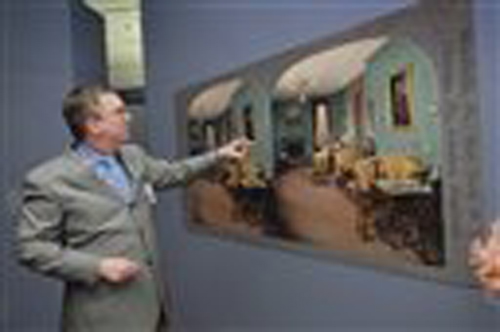Exhibit offers new ‘dimension’ of design at Winterthur museum

Mar 13, 2008
Last updated on May 12, 2016 at 10:57 p.m.
WINTERTHUR, Del. – Before high-definition TV, before DVD rentals, before movies on demand, home entertainment often meant stereographs.
To get the idea, think View-Master, an iconic baby boomer toy that offered captivating three-dimensional reel images of everything from Western landscapes to TV action heroes.
Now, turn your gaze to a new exhibit at the Winterthur museum that will have you seeing double – at least until you put on 3-D glasses.
“Double Vision: 1930s Design at Winterthur” offers the first public display of stereographs taken of the rooms and gardens at Winterthur in 1935 and 1938, before the private home of Henry Francis du Pont became a museum.
Get The Daily Illini in your inbox!
Stereographs are paired photographs taken with a camera that has two sets of lenses spaced about 2 1/2 inches apart – about the same distance between a person’s eyes. The images are then mounted on card stock for viewing through a stereoscope, which itself has two sets of lenses that transform the side-by-side two-dimensional images into one three-dimensional image.
While stereographs were once a popular form of entertainment, and later a widely used educational tool, their use at Winterthur was more documentary, as du Pont recorded for himself and his guests his early approach to design and decoration.
“What the exhibit does is take you to the birth of Winterthur in the 1930s,” said Tom Savage, director of museum affairs.
The exhibit, which runs through May 18, offers a glimpse at design styles, including art deco, Colonial Revival and Hollywood Regency. Period music playing softly in the background and black-and-white movie clips enhance the mood.
The exhibit is being displayed in conjunction with Winterthur’s second annual “Chic It Up!” design conference beginning May 16, which will focus on American design in the 1930s.
A six-minute 3-D film, during which some furniture seems to float in midair, offers a good introduction to the show, which also offers visitors the opportunity to tour and compare rooms as they look now with what they looked like more than 60 years ago. The roughly 100 stereographs on display, representative of more than 300 in the Winterthur collection, show that some rooms haven’t changed much since du Pont lived there, while others have undergone what amounts to a blue-blooded version of “Extreme Makeover.”
“These stereoviews were taken during du Pont’s most active period of collecting,” said Winterthur estate historian Maggie Lidz. “This was the first version of the rooms visitors now tour.”
Savage said he came up with the idea for the exhibit shortly after he arrived at Winterthur two years ago and saw the stereographs during a tour of the library.
“They blew my mind,” he said. “It took me right back to my six-year-old View-Master.”
The Winterthur stereographs were shot by photographer Robert Brost, then hand painted by artist Annette Karge. “In and of themselves, they are completely works of art,” said Savage, calling Karge the “Monet” of stereoview.
Brost and Karge were employees of the Keystone View Co., which was founded in 1892 in Meadville, Pa., and became a dominant player in the industry.
Meadville is now home to the Johnson-Shaw Stereoscopic Museum, which has more than 60,000 stereoviews from Keystone, which was acquired in the 1960s by the Mast Development Co. of Iowa. The bulk of Keystone’s vast archive, more than 300,000 stereoscopic prints and negatives known as the Keystone-Mast collection, was donated by the Mast family to the California Museum of Photography at the University of California, Riverside in the 1970s.
Dating to the mid-19th century, stereographs reached their zenith of popularity around the turn of the century, before the advent of radio and motion pictures. Lance Johnson of the Johnson-Shaw museum said Keystone and other companies often developed boxed sets, or books, of stereoscopic images, which were sold door to door. One of Keystone’s most popular volumes was a 1,200-image tour of the world, marketed in books of 100 images each.
“You could sit in your parlor on Sunday afternoon with your stereoscope and your 100 views … and you could literally take a trip around the world,” Johnson said.
Du Pont had a slightly different twist, however. His images were intended not to give visitors a view of the world, but to document the design elements of his estate and to offer guests an idea of how the estate’s rooms and gardens looked during different seasons of the year.
Also, when du Pont held stereoscope parties, his guests didn’t have to worry about changing cards in their viewers; butlers were on hand to do it for them.





